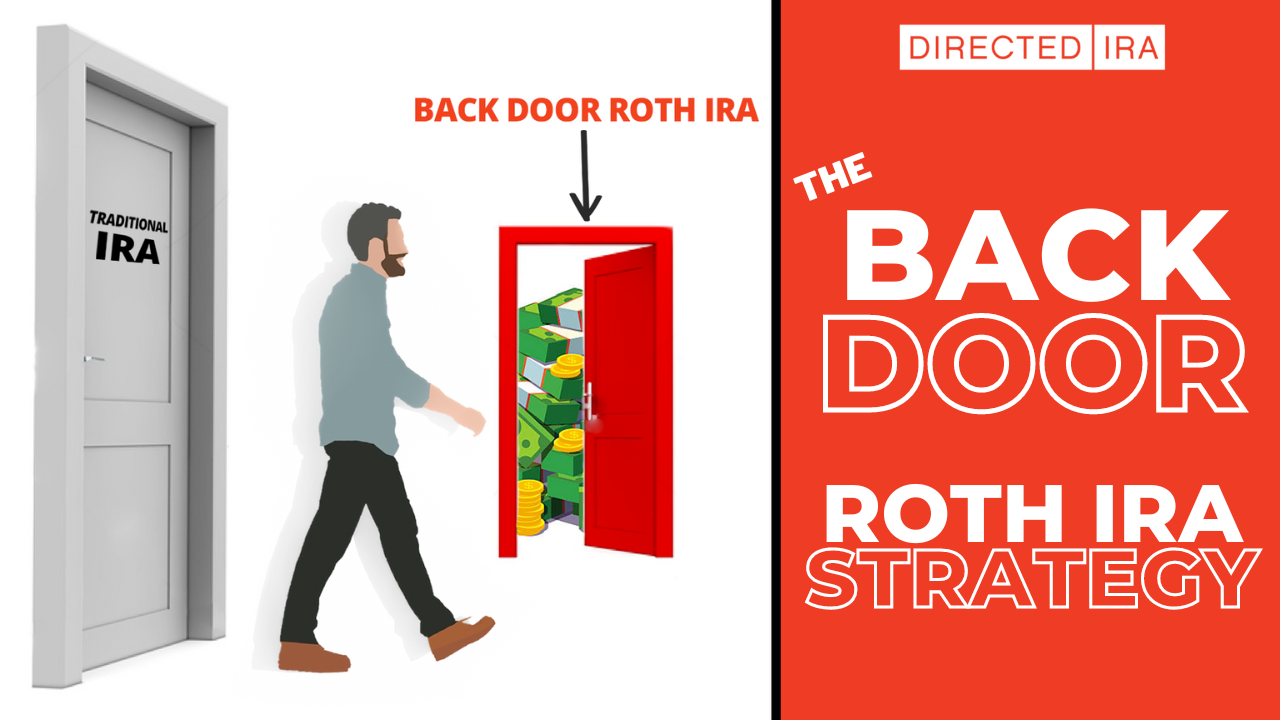Do you make too much money to contribute to a Roth IRA?
If so, the “backdoor” Roth IRA strategy is one of the best loopholes in the tax code you could utilize today. Many high-income earners believe they can’t contribute to a Roth IRA because they make too much money. This is false, and here’s why…
While direct contributions to the Roth IRA (through the “front door”) are not allowed if you exceed the IRS MAGI limits, you can still take advantage of the Backdoor Roth IRA.
What is a Backdoor Roth IRA?
A Backdoor Roth IRA consists of 3 steps facilitated by your IRA’s custodian, such as Directed IRA.
- Open and fund a Traditional IRA (or another pre-tax retirement account).
- Complete a Roth conversion.
- The result is a Backdoor Roth IRA, treated like any other Roth IRA.
What is a Roth conversion?
A Roth conversion transfers retirement funds and/or illiquid assets from a pre-tax retirement account to a Roth IRA. The IRS does not limit who can complete Roth conversions based on income.
Many types of pre-tax accounts can be converted to a Roth IRA, including:
• Traditional IRAs/Rollover IRAs
• SEP IRAs
• 401(k)s
• Solo 401(k)s
• …and more!
If you do not exceed the MAGI limits set by the IRS, you can contribute directly to the Roth IRA, which is unnecessary for the backdoor strategy. You can contribute to the Roth IRA directly through the “front door.” Keep this option in mind, though, especially if your income increases year over year. You may need to leverage this option in the near future.
Why choose a Roth IRA over a Traditional IRA/other pre-tax account?
The Roth IRA is the optimal type of retirement account that you can have as part of your
retirement strategy. Roth IRAs are funded by post-tax contributions, meaning you cannot deduct
them in the year you contribute. Since the account is funded with taxed dollars, the earnings you accrue on those dollars also grow tax-free for you to withdraw in retirement (or sooner).
The Roth IRA is an account used by the wealthiest people in the United States (i.e., Peter Thiel, Mitt Romney, and many others), but this option isn’t just available for the wealthiest. We want to share this knowledge with as many people as possible. Everyone should be able to enjoy having tax-free income in retirement.
How can I implement the Backdoor Roth IRA strategy?
Regardless of your income level, we can assist you with transitioning your retirement assets to a Roth IRA. It’s as easy as 1-2-3.
1. Open a Traditional IRA and a Roth IRA with Directed IRA.
2. Make your annual contribution to the Traditional IRA.
3. Submit a Roth Conversion request, and we’ll handle the rest!
That’s it! These three steps let you leverage the powerful Roth IRA and all its benefits regardless of your income.
Does this sound too good to be true? Because it gets even better…
With a Self-Directed Roth IRA, you can Invest in What You Know. A Self-Directed Roth IRA allows you to invest in alternative assets with your tax-free Roth IRA. We can custody a wide range of assets, including:
• Real Estate (rentals/fix and flips)
• Multi-family properties
• Private Lending/Note Investing
• Precious Metals
• LLCs/Private Placements (PPMs)/Syndications
If you don’t understand the stock market, why try to beat it? Invest in tangible, physical assets that help you build a legacy and a diverse portfolio.
Example: Imagine you purchase a property with $100,000 from your Self-Directed Roth IRA. You rent it out for a few years, then sell it for $200,000. Rinse and repeat, and when you reach 59 1/2 and meet the 5-year rule on Roth distributions, you get to enjoy that money tax-free. enjoy it tax-free.
How do I know if I can even contribute to a pre-tax retirement account?
To contribute to a Traditional IRA, you must have “earned income” in the U.S. For 2024, you can contribute up to $7,000 annually or 100% of your earned income, whichever is less. The deductibility of this contribution varies based on your income level and whether you contribute to a 401(k) plan with your employer.
Non-deductible contributions should be tracked on Form 8606.
Pro-rata Rule on Roth Conversions
If you’ve made deductible contributions to a Traditional IRA or other pre-tax account, be aware of the pro-rata rule for Roth conversions. It ensures deductible contributions are converted first, followed by non-deductible contributions.
Deductible contributions that are converted are subject to taxes. Non-deductible contributions are not.
Top 3 Questions about the Backdoor Roth IRA Strategy:
Q. Is there a dollar limit to a Roth conversion?
A. No. You can convert as much as you’d like within any tax year, regardless of income. This may trigger a taxable event, but this is intentional and part of the strategy.
Q. Can I still do a Roth conversion if I contribute to a 401(k)?
A. Yes.
Q. Do I have to convert my entire account at once?
A. No. You can convert a small amount each year, known as “chunking.” Chunking allows you to spread out potential taxes over several years.
Non-deductible IRA contributions are a typical starting point for Roth conversions. If you report a non-deductible contribution on your 1040, you don’t benefit from the deduction, so why not make these funds post-tax in a Roth IRA?
Tax Forms
Here are some tax forms to know when doing a Roth conversion or implementing the Backdoor
Roth IRA strategy:
1099-R
Reports funds or assets distributed from your pre-tax retirement account.
5498
Reports funds or assets received in your Roth IRA.
Form 8606
Reports non-deductible contributions to pre-tax retirement accounts.
Form 1040
Reports your IRA distributions and the taxable amount.
Converting non-deductible contributions doesn’t cause a taxable event. Converting earnings within your pre-tax account does.
Spousal IRAs
Spousal IRAs also qualify for this strategy. If you are married and filing jointly, your spouse can contribute to a pre-tax retirement account and convert it to a Roth IRA even without earned income.
How do I get my Backdoor Roth IRA started?
Contact the team at Directed IRA for a complimentary, getting-started call today to see if a Self-Directed Roth IRA is an option for you. We walk you through each step, assist in identifying what accounts you can utilize immediately, and begin your self-directed Roth IRA journey with you in 15 minutes or less.
Our committed team can be contacted at 1-602-899-9396, and we are ready to assist you in achieving a financially stable future.
If you need a new Roth IRA, be sure to enter this discount code BLOG50 to get $50 off your first year’s annual fee!

